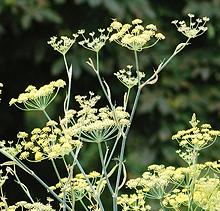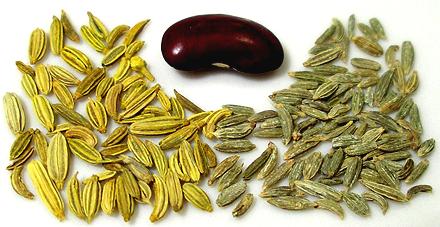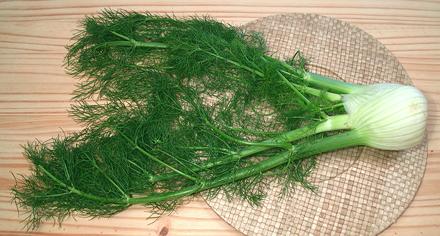 [genus Foeniculum (fennel proper), genus Ferula
(giant fennel)]
[genus Foeniculum (fennel proper), genus Ferula
(giant fennel)]
Fennel is a member of the Apiaceae family (formerly Umbelliferae), also known as the Parsley family. Originating in the Mediterranean region, fennel is now grown in many regions of the world, as an herb, a spice, a vegetable and as a medicinal plant. It is also now a common invasive weed in North America, Asia and Australia. Today, India is the top producer by a wide margin, followed by Mexico, China and Iran. Photo of flower heads by Alvesgaspar distributed under license Creative Commons Attribution-Share Alike 3.0 Unported.
More on the Parsley Family.
 [Saunf (Hindi); Mouri (Bengali); Foeniculum vulgare]
[Saunf (Hindi); Mouri (Bengali); Foeniculum vulgare]
The aromatic seeds of common fennel have many culinary uses in the cuisines of most of the world. They are used to flavor liqueurs and other beverages as well as being a component of spice mixes and curries. In Italy they are much used as a flavoring ingredient in sausages. In India roasted seeds are used as an after meal breath freshner. They also have medicinal applications.
The photo shows common fennel seeds to the left. The photo specimens were typically 0.285 inch long and 0.080 inch wide (7.2 x 2.0 mm).
 [Finocchio.(Italy), Anise (US Supermarkets - in error), Foeniculum
vulgare var. azoricum]
[Finocchio.(Italy), Anise (US Supermarkets - in error), Foeniculum
vulgare var. azoricum]
This variety of F. vulgare is milder than other cultivars and grown for its swollen leaf bases which form a bulb-like structure. It is most used in Italy where the bulbs are prepared and consumed in many forms. The fronds are also used in salads and recipes.
Buying & Storing: Even most supermarkets here in North America now carry Florence Fennel. A big problem, though, is that most stores cut the stems way too short. Many recipes call for a fair amount of the leaves for additional flavor. Loosely wrapped, fennel bulbs will last about a week refrigerated.
 [Bokhi (Armenia); Hippomarathrum siculum alt H. libanotis
var. siculum]
[Bokhi (Armenia); Hippomarathrum siculum alt H. libanotis
var. siculum]
Native to Anatolia and Caucasus, this plant is technically not a fennel,
but it's commonly called "horse fennel", looks a lot like fennel and
smells and tastes a lot like fennel, so I'm placing it here. Its stems
are used in Armenia to make a pickle (as shown in the photo) commonly
used as an appetizer. It makes a mild pickle with a pleasant and
interesting fennel-like flavor. The stems are crunchy and occasionally
a bit fibrous. Stems in the specimen jar, packed in Armenia, were 4-1/2
inches long and up to 0.45 inches diameter. The plant grows to about 3
feet in height. The genus name Hippomarathrum roughly translates
to "makes horses crazy".